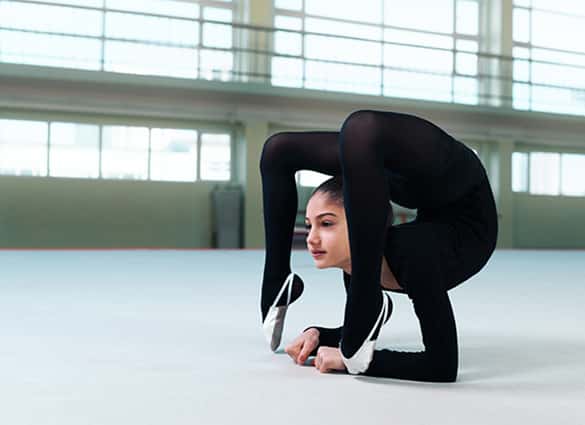
Greater range of movement
Joint hypermobility occurs when joints have a greater range of movement than is considered normal. It is often referred to as ‘double-jointedness’, ‘floppy joints’ or ‘ligamentous laxity’.
Joint hypermobility is quite common in childhood, affecting five to 15 percent of school children, and is more common in girls than in boys.
What causes joint hypermobility?
Joint hypermobility is often hereditary, and tends to run in families. Its main cause is thought to be genetically-determined changes to the connective tissue collagen. There are many different types of collagen within the body, of which joint hypermobility affects two:
- type I collagen is the most common, and is found in strong tissues like tendons, ligaments and joint capsules
- type III collagen is generally more elastic and stretchy, and found in more extensible connective tissue such as skin, lungs and the vascular system.
Joint hypermobility in children is thought to be linked to a change in the ratio between type I and type III collagen. Because collagen fibres in joint ligaments tend to bind more as we grow older, joint hypermobility tends to improve with age (this is also one of the reasons many of us become stiffer with age).
Other causes of joint hypermobility are rarer and more complex genetic disorders of the connective tissue, such as Ehler’s Danlos Syndrome, Marfan Syndrome and some types of Osteogenesis Imperfecta.


What are the symptoms of joint hypermobility?
Joint hypermobility does not necessarily lead to pain or discomfort, and many children with hypermobile joints have few or no problems as a result of their condition.
However, if your child is hypermobile and has painful symptoms, it is likely they have joint hypermobility syndrome.
Joint hypermobility syndrome can cause:
- joint pains, especially after physical activity or sport
- muscle fatigue, aches and pains, because muscles have to work harder to stabilise loose joints
- back or neck pain
- ‘growing pains’, or night time leg pain that disturbs sleep
- ‘clicky’ joints
- joint dislocations
- soft tissue injuries such as bursitis or tenosynovitis
- developmental problems such as flat feet (or collapsed arches) or an intoed gait
- poor balance and coordination, or ‘clumsiness’, due to impaired joint proprioception
- delayed onset of walking
- difficulty walking normal distances, with your child asking to be carried or sit in their pram while on family outings
- sport refusal, with your child not wanting to participate in sports involving running or jumping
- increased sensitivity to pain.
How can joint hypermobility syndrome affect my child’s development?
Joint hypermobility syndrome can have several complications for your child’s development, including:
- flat feet, in which the arches seem to sag and the feet roll in excessively. This is because the strong ligaments that normally support the arch of the foot are overly stretchy and unsupportive, allowing the arches to collapse under the child’s body weight
- reluctance to participate in school sports, because of physical discomfort or an awkward gait. A number of research studies have found that joint hypermobility increases the risk of sustaining soft tissue and joint injuries in contact sports
- a possible increased risk of developing early osteoarthritis


How is joint hypermobility syndrome diagnosed?
If your child exhibits signs of joint hypermobility, your podiatrist will assess the range of movement of a number of their joints and allocate a score, known as the Beighton Score, to each joint tested. A Beighton Score of 4 or more out of 9 means your child probably has joint hypermobility.
If your child also has painful symptoms, your podiatrist will also examine your child against a set of diagnostic criteria, known as the Brighton Criteria, to assess whether they have joint hypermobility syndrome.
What should I do if my child has hypermobile joints?
Our podiatrists in Brisbane Northside include specialists in children’s foot conditions. If your child exhibits signs of joint hypermobility, and you are at all concerned about the posture of their feet, contact us.


How is joint hypermobility syndrome treated?
If your child does not have painful symptoms, and their foot posture and arch development are normal for their age, treatment for joint hypermobility syndrome may not be required.
However, if your child has developed flat feet or collapsed arches, it is important their abnormal foot posture is corrected early, using prescription orthotics inside supportive, stable shoes. Custom orthotics can also reduce foot, ankle, knee and leg pain related to poor foot posture.
In addition to prescribing orthotics and recommending supportive school and sports footwear, your podiatrist will advise your child on specific exercises to strengthen their foot and ankle muscles and improve their balance and joint proprioception.

